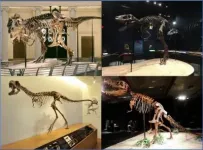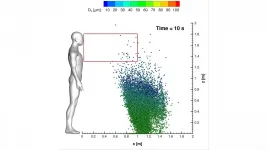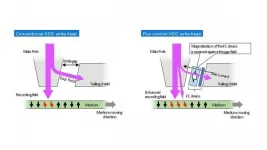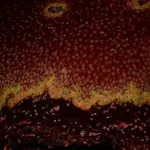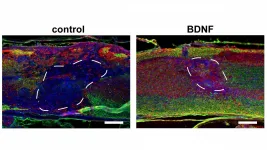(Press-News.org) WASHINGTON, March 9, 2021 -- The University of Minnesota School of Music was concerned about one-on-one teaching during the COVID-19 pandemic and wondered if it should supplement its ventilation system with portable HEPA air purifiers.
So, school officials reached out to Suo Yang, a professor within the College of Science and Engineering, and his team to figure it out. In Physics of Fluids, from AIP Publishing, Yang and the researchers describe their work to predict how virus particles spread within a music classroom.
"The airborne transmission of COVID-19 through droplets or droplet nuclei can be modeled as a typical particle-laden flow, and simulation work needs to accurately capture the movement of particles within the turbulent flow environment," said Yang. "Particle deposition onto the walls and other surfaces also needs to be captured accurately, and we wanted to explore whether particles are trapped in some recirculation zones, ventilated out, or removed by an air purifier."
Their simulations suggest that a HEPA air purifier should be placed directly in front of the person or instrument expelling aerosols and located away from other people who are to be protected within the room.
The researchers' goal was a ventilation rate of 288 cubic meters per hour, per World Health Organization guidelines, for each person within the room. To their knowledge, this is the most comprehensive investigation of using HEPA air purifiers to combat COVID-19.
"The key thing is that while portable purifiers can be very helpful, their placement is critical," said Yang.
It is absolutely critical to not spread aerosols further by inducing a very dispersive flow, according to Sai Ranjeet Narayanan, a graduate research assistant working with Yang.
One big surprise for the researchers was that portable HEPA air purifiers reduce in-air aerosols so much faster than just ventilation -- offering orders of magnitude higher aerosol removal compared to not using a purifier.
If the flow rate of the HVAC system is known, this work can serve as a guideline for the size and number of portable purifiers needed, as well as where to place them.
"Our work also provides a guideline for how long of a break between classes is necessary to ensure the safety of the next class, which is about 25 minutes for this case," said Yang.
"And it provides an analytic function, found to be a linear function, to make predictions for the aerosol removal, deposition, or suspension rate in almost any scenario: breathing, speaking, singing, coughing, sneezing, different wind instruments, with and without masks."
In the future, "we plan to model larger domains with more people, such as bands, orchestras, or any group gathering," Narayanan said. "And we may also compare the performance of different types of purifiers."
INFORMATION:
The article "Airborne transmission of virus-laden aerosols inside a music classroom: Effects of portable purifiers and aerosol injection rates" is authored by Sai Ranjeet Narayanan and Suo Yang. It will appear in Physics of Fluids on March 9, 2021 (DOI: 10.1063/5.0042474). After that date, it can be accessed at https://aip.scitation.org/doi/10.1063/5.0042474.
ABOUT THE JOURNAL
Physics of Fluids is devoted to the publication of original theoretical, computational, and experimental contributions to the dynamics of gases, liquids, and complex fluids. See https://aip.scitation.org/journal/phf.
By closely examining the jaw mechanics of juvenile and adult tyrannosaurids, some of the fiercest dinosaurs to inhabit earth, scientists led by the University of Bristol have uncovered differences in how they bit into their prey.
They found that younger tyrannosaurs were incapable of delivering the bone-crunching bite that is often synonymous with the Tyrannosaurus Rex and that adult specimens were far better equipped for tearing out chunks of flesh and bone with their massive, deeply set jaws.
The team also found that tension from the insertion of the lower pterygoid muscle is linked to decreasing stresses near the front of the typical tyrannosaur jaw, where the animals may have applied their highest impact bite ...
WASHINGTON, March 9, 2021 -- One of the primary ways the COVID-19 virus is transmitted is via airborne diffusion of saliva microdroplets, so it is paramount to find methods to kill the virus in airborne microdroplets.
The extreme confusion that abounded at the beginning of the pandemic about safe social distances, mask wearing, and social behavior inspired Marche Polytechnic University researchers, who happen to be intrigued by saliva droplet diffusion, to search for answers and ways to help.
In Physics of Fluids, from AIP Publishing, Valerio D'Alessandro and colleagues describe using a supercomputer to do numerical modeling ...
(COLUMBUS, Ohio) - To minimize transmission of COVID-19, in spring 2020, most U.S. states passed policies promoting social distancing through stay-at-home orders prohibiting non-essential travel. Vehicle-miles traveled in the U.S. decreased by 41% in April 2020 compared to 2019. A new study led by researchers at the Center for Injury Research and Policy at Nationwide Children's Hospital estimated associations between COVID-19-related social-distancing policies, traffic volume, and motor vehicle crash-related outcomes in Ohio.
The study, published today in JAMA, found the number of individuals involved in a motor vehicle crash, sustaining injury, sustaining ...
WASHINGTON, March 9, 2021 -- Researchers at Toshiba Corporation in Japan have studied the operation of a small device fabricated in the write gap of a hard disk drive's write head to extend its recording density. The device, developed by HWY Technologies, is based on a design concept known as microwave-assisted magnetic recording, or MAMR.
This technology, reported in the Journal of Applied Physics, by AIP Publishing, uses a microwave field generator known as a spin-torque oscillator. The spin-torque oscillator emits a microwave field causing the magnetic particles of the recording medium to wobble the way a spinning top does. This makes them much easier to flip over when the write head applies a recording magnetic ...
People over 65 shouldn't take three or more medicines that act on their brain and nervous system, experts strongly warn, because the drugs can interact and raise the risk of everything from falls to overdoses to memory issues.
But a new study finds that 1 in 7 people with dementia who live outside nursing homes are taking at least three of these drugs.
Even if they received the drugs to calm some of dementia's more troubling behavioral issues, the researchers say, taking them in combination could accelerate their loss of memory and thinking ability, and raise their chance of ...
PITTSBURGH, 9 March 2021 - If approved, the monthly dapivirine vaginal ring would be the first biomedical HIV prevention method designed specifically for cisgender women, as well as the first long-acting method. Looking to the future, researchers from the National Institutes of Health-funded END ...
Researchers from the group of Hans Clevers identified and characterized rare cell types in the upper gastrointestinal tract. Using single cell RNA sequencing, they studied the cellular composition of the esophagus, stomach and upper part of the small intestine. They provide detailed gene expression analyses for all epithelial cells in these organs. Furthermore, they identified a rare cell type that is most likely responsible for the secretion of high volumes of water in humans. This cell type provides a link to gastrointestinal defects in patients with cystic fibrosis. The paper was published in Cell Reports on the 9th ...
What The Study Did: Researchers compared traffic volume and motor vehicle crash injuries before, during and after COVID-19-related state-of-emergency and stay-at-home orders in Ohio from January to July last year with the same period in 2019.
Authors: Motao Zhu, Ph.D., of the Abigail Wexner Research Institute at Nationwide Children's Hospital in Columbus, Ohio, is the corresponding author.
To access the embargoed study: Visit our For The Media website at this link https://media.jamanetwork.com/
(doi:10.1001/jama.2020.25770)
Editor's Note: The article includes conflicts of interest and funding/support disclosures. Please see the article ...
Bioengineers at the University of California San Diego and San Diego State University have discovered a key feature that allows cancer cells to break from typical cell behavior and migrate away from the stiffer tissue in a tumor, shedding light on the process of metastasis and offering possible new targets for cancer therapies.
It has been well documented that cells typically migrate away from softer tissue to stiffer regions within the extracellular matrix-- a process called durotaxis. Metastatic cancer cells are the rare exception to this rule, moving away from the stiffer tumor tissue to softer tissue, and spreading ...
WASHINGTON, March 9, 2021 -- Spinal cord injuries can be life-changing and alter many important neurological functions. Unfortunately, clinicians have relatively few tools to help patients regain lost functions.
In APL Bioengineering, by AIP Publishing, researchers from UCLA have developed materials that can interface with an injured spinal cord and provide a scaffolding to facilitate healing. To do this, scaffolding materials need to mimic the natural spinal cord tissue, so they can be readily populated by native cells in the spinal cord, essentially filling in gaps left by injury.
"In this study, we demonstrate that incorporating a regular network of pores throughout these materials, where pores are sized similarly to normal cells, increases infiltration of cells from spinal cord tissue ...
